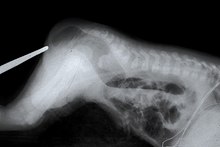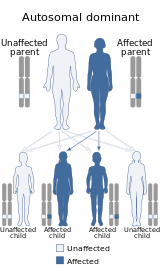Currarino syndrome
| Currarino syndrome | |
|---|---|
| Other names | Currarino triad |
 | |
| An X-ray showing Imperforate anus | |
Currarino syndrome is an inherited
Anterior sacral meningocele is the most common presacral mass in patients with Currarino syndrome, occurring in 60% of cases. Its presence may significantly affect the surgical management of these patients.[2][3] Other potential presacral masses include presacral teratoma and enteric cyst. Presacral teratoma usually is considered to be a variant of sacrococcygeal teratoma. However, the presacral teratoma that is characteristic of the Currarino syndrome may be a distinct kind.[4]
Genetics

The disorder is an
Diagnosis
Diagnosis of Currarino syndrome is usually clinical, detecting all three elements of the triad. However, genetic testing is often used as the confirmation of diagnosis and genetic analysis of patient's family members.[7][8]
Treatment
Surgery of an anterior
Early diagnosis and multidisciplinary assessment is recommended to plan adequate treatment.[10]
By accurate evaluation, the correct surgical management, including neurosurgery, can be performed in a single-stage approach.[11]
The management of Currarino syndrome is similar to the usual management of anorectal malformation (ARM) regarding the surgical approach and probably the prognosis, which mainly depends on degree of associated sacral dysplasia.[12]
Neurosurgeons are involved in the surgical treatment of anterior
Posterior approach
A posterior procedure via lumbar and sacral partial laminectomy-laminoplasty and transdural ligation of the neck of the meningocele is used for anterior sacral meningoceles; alternatively, tumor excision is used for other types of presacral lesions.[citation needed]
Endoscopic or endoscope-assisted surgery via a posterior sacral route can be feasible for treatment of some patients with anterior sacral meningocele. Anterior meningocele pouch associated with Currarino syndrome will regresses over time following transdural ligation of its neck.[citation needed]
See also
References
- PMC 4249588.
- S2CID 45316326.
- PMID 11101738.
- S2CID 260135903.
- PMID 4418917.
- PMID 10631160.
- PMID 28065719.
- PMID 16254195.
- S2CID 45316326.)
{{cite journal}}: CS1 maint: multiple names: authors list (link - PMID 11101738.)
{{cite journal}}: CS1 maint: multiple names: authors list (link - PMID 16410121.)
{{cite journal}}: CS1 maint: multiple names: authors list (link - PMID 28065719.)
{{cite journal}}: CS1 maint: multiple names: authors list (link
- currarino_syndrome_treatment [Operative Neurosurgery] Archived 2020-11-30 at the Wayback Machine
